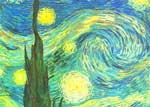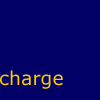Vincent
Van Gogh
Diseases
exist to remind us that we are not made of wood, and it seems
to me this is the bright side of it all
Vincent: January 1890
Vincent
Van Gogh was one of the greatest artists the world has seen. His
paintings document the life of a driven but fragile artist who
experienced bouts of ill health throughout his painting life.
Speculation about the health of Vincent Van Gogh includes a diagnosis
of epilepsy. Vincent was most likely affected by Complex Partial
seizures, which include sensory disturbances.
A
doctor who treated him noted that these seizures involved
'acute
mania with hallucinations of sight and hearing'
A
diagnosis of epilepsy was made by two seperate doctors who treated
him.
May 8th 1889 - Monthly notes by the asylum physician
in the asylum book
"the
hallucinations of sight and hearing "terrified"
the patient and "he retains only a vague memory (of the ear
cutting incident) and cannot explain it. He tells that one
of his mother's sisters was epileptic, and that there are several
cases in the family" Dr Peyron, another physician involved
in his care noted,
"I
believe that monsieur Van Gogh is subject to epileptic fits
at very great intervals."
 An
example of his epilepsy occurred when Vincent was painting a landscape
in the fields of St Paul de Mausole. He felt a pressure on his
head which tightened like a metal band. Trembling he fell
to the ground, his body went rigid a scream coming from his lips.
Then everything went dark. He was carried back to St Remy,
where he was in a state of agitated confusion not really knowing
who he was for three weeks. An
example of his epilepsy occurred when Vincent was painting a landscape
in the fields of St Paul de Mausole. He felt a pressure on his
head which tightened like a metal band. Trembling he fell
to the ground, his body went rigid a scream coming from his lips.
Then everything went dark. He was carried back to St Remy,
where he was in a state of agitated confusion not really knowing
who he was for three weeks.
Vincent wrote to Theo his brother,
'For
many days I have been completely lost as in Arles, as badly
if not worse, and one can only presume these attacks will return
in the future; it is abominable....this latest attack, dear
brother, came upon me in the fields when I was painting on a
windy day.'
Following the
famous ear-cutting incident, (another possible seizure, in which
Van Gogh severed part of his ear-lobe and was hospitalised), he
wrote to his friend the painter, Paul Gaugin,
"In
my mental or nervous fever, or madness - I am not too sure how
to put it or what to call it - my thoughts sailed over many
seas. I even dreamed of the phantom Dutch ship and of
Le Horla, and it seems that, while thinking what the woman
rocking the cradle sang to rock the sailors to sleep,
I, who on occasions cannot sing a note, came out with an old
nursery tune, something I had tried to express in an arrangement
of colours before I fell ill, because I don't know the music
of Berlioz."
Further
extracts from his diaries, throw some small but further light
on his epilepsy
"there
are moments when I am wrenched by enthusiasm or madness or prophesy
like a Greek Oracle."
"I
have had in all four great crises during which I didn't
know what I said, what I wanted, and what I did... I had previously
had three feinting fits without any plausible reason, and without
retaining the slightest remembrance of what I felt."
"I
am unable to describe exactly what is the matter with me; now
and then there are horible fits of anxiety, apparently without
cause, or otherwise a feeling of emptiness and fatigue in the
head."
|

